Tom Stern, ASC, AFC, directs the lighting of a Master Class at La fémis film school
By François Reumont on behalf of the AFCHaving just finished shooting Clint Eastwood’s latest film (partially filmed in the Paris region and in a real Thalys train between Arras and Paris), Tom Stern participated in a question-and-answer session as part of an invaluable Master Class he ran for the students in the image program. Three days of high-speed discussions with the cinematographer of Million Dollar Baby and Gran Torino involved sharing confidences about the profession, exciting stories, and technical advice during a workshop he held on a set in the studios on the rue Francœur.
“Because I worked as a gaffer with Conrad Hall and Haskell Wexler for such a long time, I learned a certain philosophy of simplicity in lighting from them,” Tom Stern explains to the apprentice cinematographers. “For example, during one of my first shoots with Conrad – it was an advertisement for beer or soda…I cant remember which ! – we were doing location scouting outdoors in the countryside in broad daylight. After having spent the morning painstakingly noting all of the positions that would be appropriate for the placement of the arc lamps for the different shots (HMIs weren’t yet available then), faced with a Conrad Hall who was absolutely mute, he took me aside and said to me with a malicious smile : ‘You know, Tom, in daylight, I try not to relight !’ And I realized that he was right. Sunlight is extremely difficult to recreate off set and so I usually try to rely on it, to reflect it or to diffuse it without falling into the trap of trying to imitate it or counter it with lights—no matter how strong they may be !”
To demonstrate that simplicity, the American cinematographer chose to build a series of scenes in the Oriental set that La fémis provided for the occasion. “We’ll do something Lawrence-of-Arabia style,” he said jokingly. While the students were setting up the camera and the frame, others took place around a table to play the actors. “It’ll be a scene where they’re selling camels in a Bedouin tent, we’re first going to shoot a wide shot to show the situation, and then we’ll zoom in on the actors.”
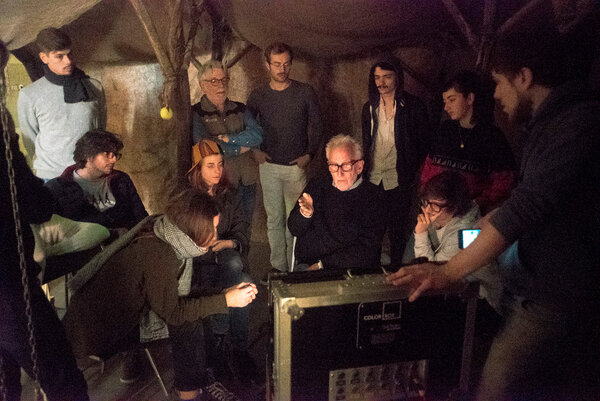
A devoted user of tungsten lighting, the cinematographer doesn’t vary his working methods. “I love Arri T12s (10 or 12K),” he explains. “They’re my favourite lamps. I even bought thirty of them that I use on all my films. Sometimes I also use the 24K version, but that’s rarer. On the closing scene of Mystic River, we set up a 24K tungsten on a crane about 500 metres above the comedians. Just one light source, a few reflectors, and voilà ! Simplicity !”
While the students are setting up the spotlight, the cinematographer gives them some advice. “When you’re on a set, always begin by lighting the Fresnels in spot mode. That lets you aim them with precision… besides, I find that lighting is more interesting to work with in spot mode than in flood mode. Things happen that I can’t really explain and that give more life to what we’re filming.”
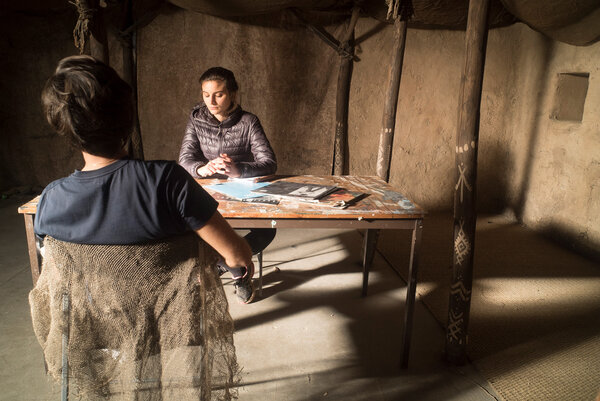
Placed perpendicularly about 3.5 metres from the actors, the 10K is in full spot mode, delivering a level of lighting that seems ridiculous to people used to working with the very low levels of light required by digital cameras. “I like filming at T:8 or even T:11 indoors. I’m not afraid of the depth of field, on the contrary, I find it brings meaning in many cases, allowing a better view of the set and sometimes of the action. It’s rare that I film with a fully open aperture. Most of my films have basically the same aperture on most of the shots, either T:4 or T:5.6. Afterwards, if I need to break up the depth, I of course use neutral density filters and adjust the aperture accordingly.”
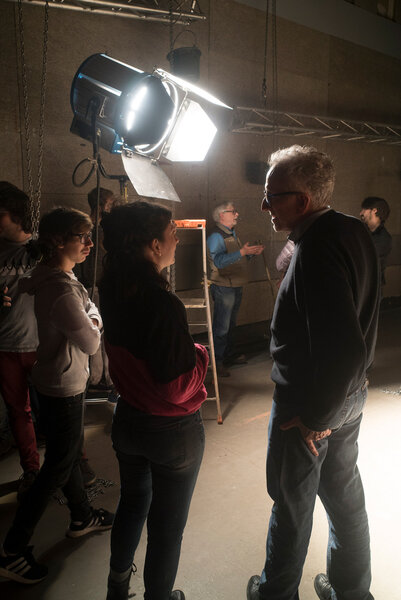
In order to shape the image and work on the lighting, Tom Stern had the students set up a 250 barndoor that cut the footprint of the 10kW in two. “You’ve got to install it from the top, so the top of the beam that hits the actors is slightly diffused, while the lower part of the beam that hits their legs and the ground remains naked. That helps keep contrast on the left side of the frame while softening the faces a bit.”
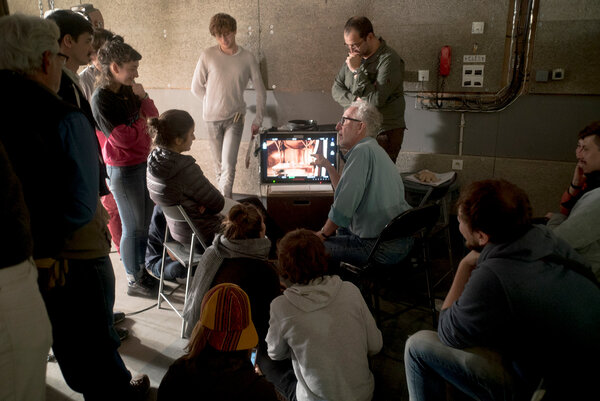
Continuing his thoughts aloud, the cinematographer insists on contrast in depth. “Most of the time, I try to light from the outside of the set using the fewest lamps possible. Nonetheless, sometimes you have to add a touch of light in some places within the frame to overcome the lack of space one might have on a particular set, and especially the relative proximity of the light sources in comparison with natural sunlight.”
To do that, he installed two other Fresnels (2K and 1K) to give the set some texture (right foreground and left background). “I like to use low lights for that. It gives the image lots of texture.”
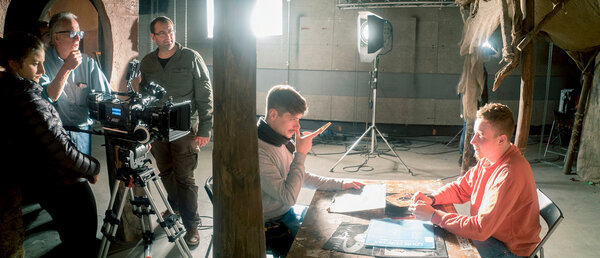
Another thing, he prefers high contrast. “Don’t be afraid of white ! Of course, every camera reacts differently to overexposure. But most of the time, during colour timing, you can recover some texture. It’s the sensation of contrast between black and white that allows you to construct the image…”
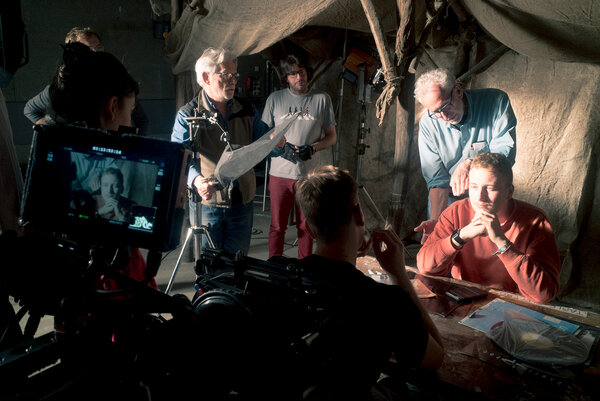
Questioned by the students on colour timing, Tom Stern admits that there, too, he is an advocate of “less is more”. “I almost always work with the same colour timers, like Isabelle Julien, in France. Colour timing must happen quickly for me, not more than a few days, one week at most. I take two laser pointers with me while watching the film, and I tell the colour timer to change the contrast here, or to darken a particular part of the image. Out of the question for me to get involved in 50 moving masks… that exhausts me !”
As to camera settings and especially on white balance, the cinematographer admits : “Personally, I stay faithful to the method we used before digital. Meaning that I set the camera at 3,200 or 5,600 and never move from there. That way, I’m pretty much sure that the dailies will be good and there will never be a mistake in interpretation by the digital lab. Of course, there are a few exceptions, such as if I film with fluorescent lights that I can’t change, and which require intermediary adjustments. But otherwise, It’s always tungsten or daylight.”
Another piece of advice given to the students of La fémis : “Forget viewfinders !” warns Tom Stern. It’s the accessory used by bad directors who don’t understand cameras. Always bring along a good spyglass you can use to discreetly observe the actors’ faces from very close up. It’s a tool I use all the time and that I’ve been using since I was a gaffer. That way you can place yourself in the camera axis and can control shine, the effect of a particular reflector on the face, or how well a false moustache or wig is holding up, because those can easily shift during the day.”
Simplicity, humour, and rapidity. Three qualities one thinks of when observing the gentleman. “You know the Hollywood joke about cinematographers ?” asks Tom Stern… “When you choose one, it’s like meeting a good genie. ‘Good,’ ‘Fast,’ and ‘Inexpensive’ are the three qualities you ask for. But no matter who you choose, the genie can only grant two out of your three wishes !”
(Translated from French by Alexander Baron-Raiffe)
 En
En Fr
Fr




